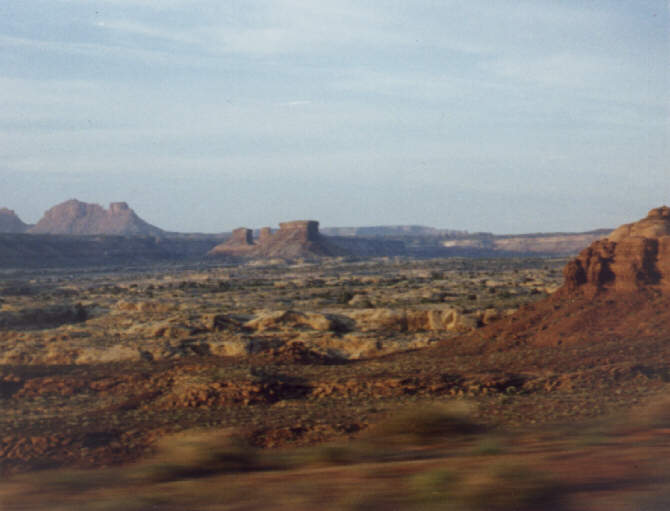 Another Stereotype of the Month entry and response to Hopis vs. Big Mountain Trespassers:
Another Stereotype of the Month entry and response to Hopis vs. Big Mountain Trespassers:
 Another Stereotype of the Month entry and response to Hopis vs. Big Mountain Trespassers:
Another Stereotype of the Month entry and response to Hopis vs. Big Mountain Trespassers:
Hopi 'apartheid'
Louise Benally displays law enforcement patches -- "BIA Junior Police" and "Hopi Junior Ranger" -- that rain washed down from Camp Anna Mae Sun Dance grounds after Hopis fenced it.
Allegedly spurred on by a white, South African press officer, the Hopi Nation launches what some Navajos call a program of segregation.
'Apartheid attitude' cited in Hopi fencing of sun dance grounds
By Brenda Norrell
Special to Navajo Times
BIG MOUNTAIN, Ariz. | July 25, 2002
When the Hopi Tribe fenced off the sun dance grounds, they believed they stopped the dancing. But little do they know, all created things are dancing, this land is alive, say Navajos here.
Feeding her baby goats and waiting for Hopi rangers to slowly cruise her hogan at sunrise, Louise Benally said, "It is an organized hate crime brought on by the Hopi tribal government."
Benally said most Hopi villagers support Navajos resisting relocation and only a half dozen Hopi tribal officials mandate the abuses of Camp Anna Mae sun dance grounds.
Hopi tribal public relations officer Claire Heywood (who is white from South Africa), Benally says, is among those responsible. "Claire Heywood posted the 'No trespassing' signs. She needs to take her apartheid attitude back to South Africa," Benally said.
Hopi rangers maintaining the stakeout at the sun dance grounds in July are documented on home video.
Benally said, "The only time we see any Hopi officials is when they are driving in government vehicles with United States plates."
Waste of resources
With the air hot and choking dry, Benally said the assault on the sun dance grounds is a waste of resources. Navajos here drive a 50-mile round trip to haul their water in buckets and barrels or buy water at the Hard Rock Chapter House.
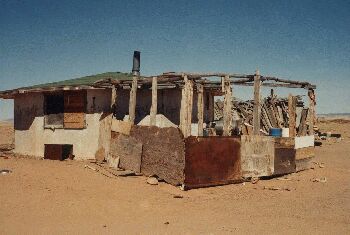
"We need water, it has been so dry. We need everything. Fencing off the sun dance grounds and these constant Hopi patrols are a waste of resources," Benally said.
"But no matter how beaten we get, our spirits are strong and we remain. The determination of our spirits is deeper."
Speaking on behalf of the Hopi Tribe, Heywood denies Navajos are being harassed at Big Mountain.
"The residents of Big Mountain are not being harassed at all. Tribal employees are working in the area which they have every right to do because it is Hopi land," she said.
"So far there has been contact between Hopi tribal employees and people living in the area twice: once Louise Benally greeted the party who were surveying the area (GPS) with, 'What are you f------- a------- doing here?'" Heywood said.
"As far as I know, after a short discussion she then left," Heywood said.
"The second incident was an amicable incident when Kee Benally came over to videotape two employees posting 'no trespassing' notices which were posted in the area because it is closed. Neither of these incidents can be considered harassment, whichever way you look at it."
No objections
Although Lakota and Cheyenne have spoken out about the desecration here, Heywood denies that American Indian tribes are concerned with the Hopi Tribe's destruction of the sun dance grounds.
Benally and four other women were arrested while bringing in the Sun Dance Tree in July 2001. Then the sun dance grounds were bulldozed, the arbor and sweatlodges destroyed, by Hopi police in August 2001.
Hopi officials returned this summer and fenced the sun dance grounds with barbed wire and yellow police tape and posted "No Trespassing" signs. Heywood said, "We have received no notice of any Lakota leaders being concerned over an incident that took place almost a year ago. In fact, following the dismantling of the site we wrote letters to the leadership of every Lakota Tribe and not one responded with any indications of concern.
"On the other hand, we have had a number of individual Lakotas support our efforts to stop non-Lakota performing a ceremony on non-Lakota land. This was expressed either through letters, telephone calls or personal interviews with a couple of Lakota who live in this area."
Referring to the Camp Anna Mae Sun Dance, led by Joe Chasing Horse, Lakota, Heywood said individual Lakotas have stated concerns.
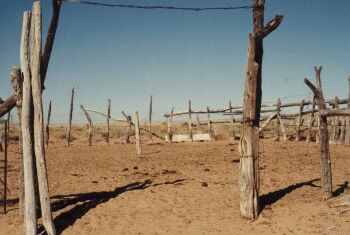
"They expressed that they in no way support a sun dance at Big Mountain and that Chasing Horse should be at home looking after his own people," she said.
With sun dances underway throughout the West in July, Chasing Horse could not be reached for comment.
Power-tripping
Meanwhile, Benally, long supported by Hopi Sinom elders, said Hopi never lived at Big Mountain.
"They cannot claim this land based on aboriginal land rights," he said.
"Hopis only lived on the mesas, that is where they were instructed to live.
"The Hopi villagers tell us that this is all just a few politicians power-tripping on each other and with government funds," he said. "They have no respect and want the land for economic development such as mining.
"Hopi have no ancestral ties to the land. There are only Anasazi ruins out here," he added. "The world renewed itself in the last purification and the Anasazi were wiped out."
Now, with coal mining and the fear of future uranium mining, he said, "They take out the poisons and then don't know where to put them. No one wants these poisons on their land."
Sending support to Shoshone fighting to preserve their ancestral lands and fighting nuclear waste dumping in Nevada, Benally said Navajos are also the victims of the nuclear industry because they are downwinders from Nevada.
"The Shoshone also had their livestock taken away by government cowboys," she said, adding that the battle for water rights is the primary struggle for American Indians.
"We use to have a lot of water before Peabody Coal," Benally said of the pumping of groundwater for the transport of coal in slurry line.
Like hyenas
Finally, remembering the anguish that the news of relocation laws created for her parents, when she was 10-years old, Benally said, "If people had understood English and understood the tricks, this would have never happened.
"My parents would get up at 4 a.m. and talk about it. We were kids and didn't understand it," she said. "Now, we really understand it."
With a smile, Benally picks up gold-colored foil stick-on patches, which washed down the mesa in a brief rain from the fenced off and patrolled sun dance grounds.
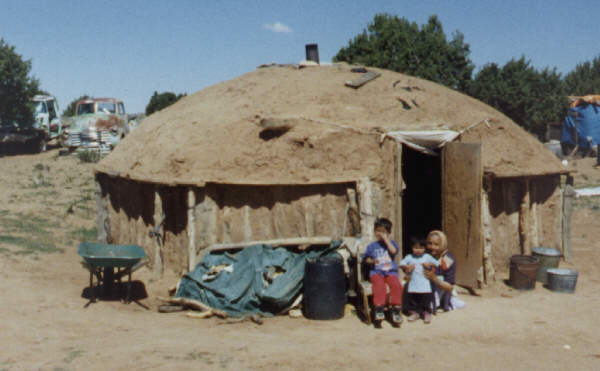
One of the sticker identification badges reads, "Junior Police, BIA Police, Truxton Canyon Agency." Another reads, "Resource Enforcement, Hopi Junior Ranger."
Serious and watching for the rangers to drive up to the sun dance grounds or position their vehicles above her hogan on the mesa, Benally said, "They are like starving dogs, hyenas, they get closer and closer, then they attack and eat their prey."
Copyright © 1999-2002 | Navajo Times/Navajo Nation
Rob's comment
Could Norrell possibly have chosen a more inflammatory headline than "Hopi Apartheid"? What's next..."Hopi Genocide"? How is it apartheid to insist on sovereign control of your ancestral land?
Norrell's "reporting" on the issue is atrocious. For starters, she never bothers to interview anyone remoted affiliated with the Hopi side—although they've won every court case against the resisters. If she can't find a single Hopi to interview, she should contact me. I'll give her a quote to burn her ears.
Wait, she did interview Claire Heywood, an Anglo spokeswoman supposedly from South Africa. Between interviewing Heywood alone and linking her to South Africa's apartheid regime, Norrell unfairly underminded Heywood's credibility. Worse, Norrell explicitly states (with zero evidence) that Heywood has "spurred on" the Hopi Rangers. A casual reader comes away with the impression that white supremacists have infiltrated the Hopi Tribe, taken it over, and are now conspiring with the US government against Native people.
But which Native people? Again, note that nowhere are the 10,000 Hopi people mentioned in this scenario. The implication is that they're too naive or stupid to see what the rapacious American and South African imperialists are doing to them. That's stereotypical and nasty to boot.
Most of the Hopi support the resisters? Where did Norrell get that from—thin air? That doesn't remotely resemble anything I've heard or read on the subject. And of course she has no source for this imaginative statistic.
In fact, except for the usual unnamed "elders," I've never heard any Hopi say they supported the resisters.
One point worth noting: Most Hopi opposed the recent Hopi-Reliant energy deal. They opposed it because they felt it went against their values. Consequently, they quickly mobilized against it in public meetings and demonstrations. If most Hopi felt the same way about Big Mountain—that the Tribal Council was giving it away to Peabody—why wouldn't they organize and demonstrate the same way? Where are the organized Hopi protests against the Tribal Council on this issue?
Nowhere, obviously. Because the Hopi insist on sovereignty over their land.
Norrell's assertion that the Hopi never lived at Big Mountain is irrelevant. You don't have to live on a piece of land to own it. The Navajo haven't occupied some huge percentage of their land—95 percent?—yet they claim sovereignty over all of it. Try building a camp and doing a Sun Dance on an unoccupied parcel within a mile of Window Rock, or in Monument Valley, and see what happens. Peace, love, and brotherhood? I'm guessing not.
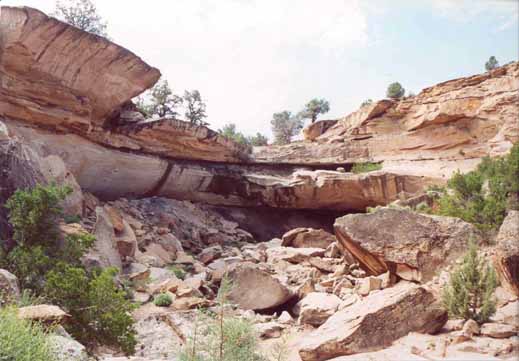
The assertion also ignores the well-known Native belief that a people's culture and religion (these English words are essentially the same to many Indians) are inextricably bound to their land. That means all their land, not just the place where they're living physically. A Hopi spring or shrine 100 miles from the three mesas might be considered as central to Hopi life as the inhabited villages. To claim otherwise is, again, stereotypical white-woman's thinking.
As for this statement:
"Hopi have no ancestral ties to the land. There are only Anasazi ruins out here," he added. "The world renewed itself in the last purification and the Anasazi were wiped out."
it's flatly false and shows a profound ignorance of Hopi history. The Hopi claim the Anasazi as their direct ancestors. The Anasazi ties to the land are their ties to the land.
In Hopi creation myths, the preceding Third World was destroyed in the unknown past before history began. I've never seen any source, Hopi or otherwise, link this destruction to a historical period, much less to the Anasazi decline and "disappearance" around AD 1200.
In fact, I've never seen a Hopi source claim the Anasazi were "wiped out." Again, many Hopi would say the Anasazi are still alive—in the form of the Hopi and other Pueblo people.
Moral of the story: Don't believe everything you read. Especially if it's a Big Mountain article by Brenda Norrell.
Related links
Looking Horse says Diné foes a have "disease of the mind"
Newspapers write about a "traditional Navajo Sundance"
Hopis vs. Big Mountain trespassers
|
. . . |

|
All material © copyright its original owners, except where noted.
Original text and pictures © copyright 2007 by Robert Schmidt.
Copyrighted material is posted under the Fair Use provision of the Copyright Act,
which allows copying for nonprofit educational uses including criticism and commentary.
Comments sent to the publisher become the property of Blue Corn Comics
and may be used in other postings without permission.